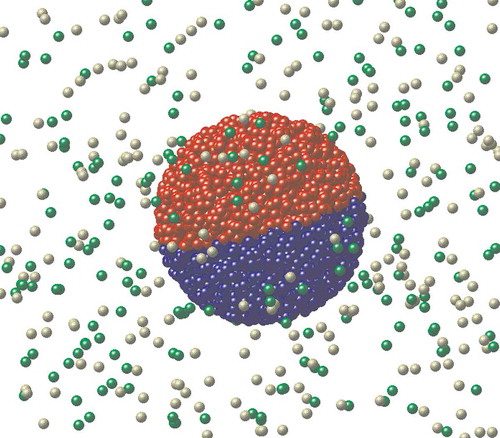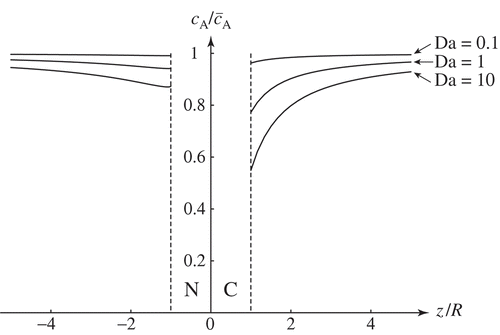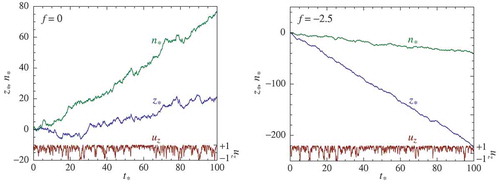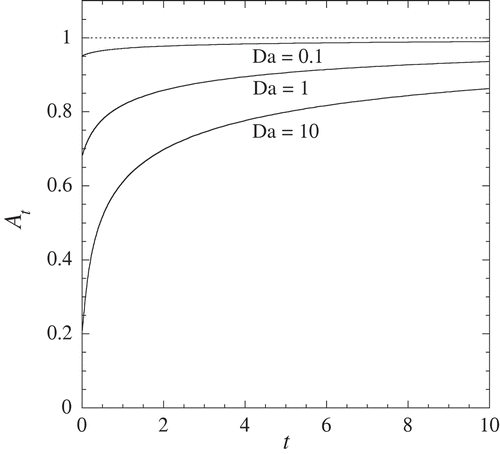Figures & data

Figure 1. Relative concentration profiles of the fuel A along the axis of the Janus particle for three values of the Damköhler number. C and N denote the catalytic and non-catalytic hemispheres, respectively. The profiles are obtained for
.

Figure 2. Streamlines of the velocity field (22) around a Janus particle in the laboratory frame where the particle moves with the velocity for
,
, and
from [Citation56]. The vertical axis
corresponds with
of the Janus particle. The upper hemisphere is catalytic. The motor here behaves as a pusher with
. The blue arrow denotes the direction of particle motion and black arrows the fluid flow.
![Figure 2. Streamlines of the velocity field (22) around a Janus particle in the laboratory frame where the particle moves with the velocity Vsd=2Υa1/3 for Re≃0.013, Pe≃0.17, and Da≃6.2 from [Citation56]. The vertical axis z corresponds with u of the Janus particle. The upper hemisphere is catalytic. The motor here behaves as a pusher with Υa2<0. The blue arrow denotes the direction of particle motion and black arrows the fluid flow.](/cms/asset/9fb57ee6-f535-4f9e-b593-07e5543b7816/tapx_a_1602480_f0002_oc.jpg)
Figure 3. Janus particle subjected to an external force and magnetic field oriented in the -direction: The random rescaled displacement
, the number of reactive events
, and the particle orientation
, versus the rescaled time
for parameter values
,
, and
and (left) a zero external force, and (right) a rescaled external force equal to
.

Figure 4. Janus particle subjected to an external force and magnetic field oriented in the -direction [Citation61]: The mean values of the fluctuating rescaled velocities
and rate
versus the rescaled magnitude of the external force
for the parameter values
,
, and
. The dots show the results of a numerical simulation with a statistics of
trajectories integrated over the time interval
.
denotes the rescaled stall force and
the threshold between fuel synthesis and consumption. The Janus particle is propelled against the external force in the interval I. Fuel synthesis happens in the interval II.
![Figure 4. Janus particle subjected to an external force and magnetic field oriented in the z-direction [Citation61]: The mean values of the fluctuating rescaled velocities r˙∗=r˙/DtDr and rate n˙∗=n˙/DrxnDr versus the rescaled magnitude of the external force f=βFDt/Dr for the parameter values βμB=2, Wrxn/DrxnDr=0.8, and χDrxn/Dt=0.8. The dots show the results of a numerical simulation with a statistics of 105 trajectories integrated over the time interval t∗=10. fstall denotes the rescaled stall force and f0 the threshold between fuel synthesis and consumption. The Janus particle is propelled against the external force in the interval I. Fuel synthesis happens in the interval II.](/cms/asset/50d0b6c6-7a36-4392-8813-e94828fa8e62/tapx_a_1602480_f0004_oc.jpg)
Figure 5. Simulations with microscopically reversible kinetics of the Janus motor subjected to an external force and a magnetic field both oriented in the
-direction: Plots of the dependence on the rescaled force
of the rescaled average motor velocity in the
-direction,
(left), and of the rescaled reaction rate,
(right) for systems with (a)
and
(circles) and (b)
and
(squares). The results for (a) and (b) systems were obtained from averages over 200 and 100 realizations of the dynamics, respectively. The fits to the data are indicated by (a) upper and (b) lower lines. See Huang et al. [Citation62], for additional information.
![Figure 5. Simulations with microscopically reversible kinetics of the Janus motor subjected to an external force Fext and a magnetic field both oriented in the z-direction: Plots of the dependence on the rescaled force f of the rescaled average motor velocity in the z-direction, ⟨z˙∗⟩ (left), and of the rescaled reaction rate, ⟨n˙∗⟩ (right) for systems with (a) cˉA=10 and cˉB=9 (circles) and (b) cˉA=10 and cˉB=10 (squares). The results for (a) and (b) systems were obtained from averages over 200 and 100 realizations of the dynamics, respectively. The fits to the data are indicated by (a) upper and (b) lower lines. See Huang et al. [Citation62], for additional information.](/cms/asset/514f8a0c-77b2-4ece-8bef-6f277bbe8606/tapx_a_1602480_f0005_oc.jpg)
Figure 6. Schematic representation of the different regimes of the active particle in the plane of the mechanical and chemical affinities for [Citation53]. In domain I, self-diffusiophoretic mechanical work is powered by the reaction. In domain II, an external force of sufficient magnitude acting in a direction opposite to that of the Janus particle velocity can yield the synthesis of fuel from the product. For
, the slopes of the lines
and
are instead positive.
![Figure 6. Schematic representation of the different regimes of the active particle in the plane of the mechanical and chemical affinities for χ>0 [Citation53]. In domain I, self-diffusiophoretic mechanical work is powered by the reaction. In domain II, an external force of sufficient magnitude acting in a direction opposite to that of the Janus particle velocity can yield the synthesis of fuel from the product. For χ<0, the slopes of the lines ⟨z˙⟩=0 and ⟨n˙⟩=0 are instead positive.](/cms/asset/134372d6-270d-487f-918f-654cd5fe58d5/tapx_a_1602480_f0006_oc.jpg)
Figure 7. Schematic representation of the probability distributions of opposite fluctuations in the number
of reactive events occurring during the time interval
under nonequilibrium conditions.
![Figure 7. Schematic representation of the probability distributions P(±n,t) of opposite fluctuations in the number n of reactive events occurring during the time interval [0,t] under nonequilibrium conditions.](/cms/asset/770913ae-d75f-4ef1-8c52-4971607dc16e/tapx_a_1602480_f0007_b.gif)
Figure 8. Janus particle subjected to an external force and magnetic field oriented in the -direction [Citation61]: (a) Probability density
with
versus the rescaled displacement
at the rescaled time
for the parameter values
,
,
, and
. (b) Verification of the mechanochemical fluctuation relation (46) in the same conditions. The probability ratio is calculated if
and
are larger than
. The dots are the results of a numerical simulation with an ensemble of
trajectories and an integration with the time step
. The lines depict the theoretical expectations.
![Figure 8. Janus particle subjected to an external force and magnetic field oriented in the z-direction [Citation61]: (a) Probability density P(z∗,n∗;t∗) with n∗=nDr/Drxn=2,1,0,−1,−2 versus the rescaled displacement z∗=zDr/Dt at the rescaled time t∗=Drt=1 for the parameter values βμB=1, βFDt/Dr=−1, Wrxn/DrxnDr=0.4, and χDrxn/Dt=0.4. (b) Verification of the mechanochemical fluctuation relation (46) in the same conditions. The probability ratio is calculated if P(z∗,n∗;t∗) and P(−z∗,−n∗;t∗) are larger than 10−4. The dots are the results of a numerical simulation with an ensemble of 107 trajectories and an integration with the time step dt∗=10−3. The lines depict the theoretical expectations.](/cms/asset/9f5b9e7e-3911-43e0-9bba-282e635a23e4/tapx_a_1602480_f0008_oc.jpg)
Figure 9. Time-dependent affinity of the finite-time fluctuation theorem for an immobile Janus particle of radius
with surface reaction influenced by the diffusion of fuel and product from a spherical reservoir at the distance
from the particle center. The asymptotic value of the affinity is equal to
(dotted line). The diffusion coefficients take the value
and the rate constants
. The Damköhler number is given by
.

